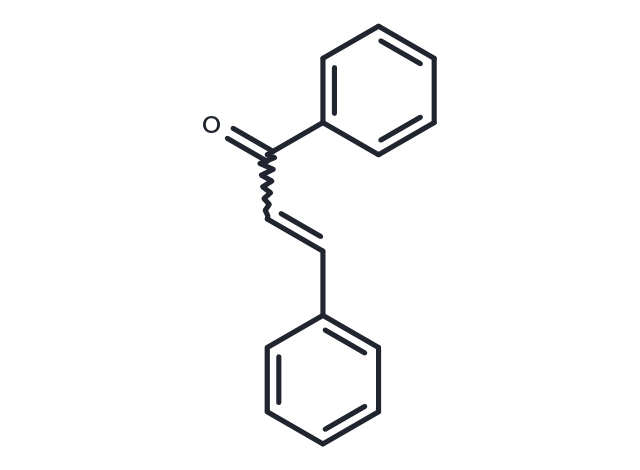Powder: -20°C for 3 years | In solvent: -80°C for 1 year


Chalcone (Cinnamophenone) is an aromatic ketone that forms the central core for a variety of important biological compounds, which are known collectively as chalcones.

| Pack Size | Availability | Price/USD | Quantity |
|---|---|---|---|
| 100 mg | In stock | $ 41.00 | |
| 200 mg | In stock | $ 64.00 | |
| 500 mg | In stock | $ 116.00 |


| Description | Chalcone (Cinnamophenone) is an aromatic ketone that forms the central core for a variety of important biological compounds, which are known collectively as chalcones. |
| Targets&IC50 | EGFR:10 µM (in A431 cells) |
| In vitro | AG99, a potent inhibitor of EGFR, was shown to inhibit the appearance of pp145 to some extent. AG99 promotes cell death of normal and cancer cells via activation of caspase-like proteases in vitro [2]. |
| Cell Research | Human bladder carcinoma cell line 5637 was maintained in RPMI1640 medium supplemented with 10% fetal calf serum (FCS), 1 mM L-glutamine, and antibiotics. Cells were grown at 37°C in a humidified 5% CO2 atmosphere. For all experiments, confluent cells were trypsinized, and aliquots of single-cell suspension were re-seeded at 0.5×10^6 cells/dish (100-mm diameter) or 0.1×106 cells/dish (60-mm diameter) and cultured in poly-L-lysine-coated new culture dishes containing normal culture media for 24-48 hours. After the normal growth treatment, cells were treated under several different conditions as specified in the text. When cell number and cell viability were determined, both attached cells and unattached cells were collected by trypsinization and sedimentation of the culture media, respectively, and combined in one tube. The cells were washed twice with phosphate-buffered saline (PBS) and aliquots of the cells were stained with Trypan Blue solution. After the staining, cells were mounted in a hemocytometer for microscopic observation. Total cell number was determined by counting more than 300 cells per condition. The percentage of Trypan-Blue-stained cells (versus total cell number) was determined by calculation of data obtained with three independent counting of more than 100 cells. When nuclear morphology was evaluated, cells were grown and treated in glass-bottom dishes. After treatment, the cells were washed three times with PBS, fixed with 4% paraformaldehyde in PBS for 10 minutes, permeabilized with 0.2% Triton X-100 in PBS for 2 minutes and blocked with 3% BSA in PBS for 1 hour. Cells were then treated with propidium iodide at 2 μg/ml in PBS for 1 hour. After washing with PBS (three times 5 minutes), samples were mounted in PBS containing 50 mg/ml 1,4-diazabicyclo[2,2,2]octane and 90% glycerol and subjected to confocal microscopic observation. The fluorescence was detected at 543 nm argon excitation using optics of a 590 nm long-pass barrier filter.The fluorescent images were recorded and reconstituted with the use of software Adobe Photoshop CS [2]. |
| Synonyms | benzylideneacetophenone, phenyl styryl ketone, Cinnamophenone, benzalacetophenone, β-phenylacrylophenone |
| Molecular Weight | 208.26 |
| Formula | C15H12O |
| CAS No. | 94-41-7 |
Powder: -20°C for 3 years | In solvent: -80°C for 1 year
DMSO: 201.7 mM
H2O: 4.8 mM
You can also refer to dose conversion for different animals. More
bottom
Please see Inhibitor Handling Instructions for more frequently ask questions. Topics include: how to prepare stock solutions, how to store products, and cautions on cell-based assays & animal experiments, etc.
Chalcone 94-41-7 Angiogenesis JAK/STAT signaling Microbiology/Virology Tyrosine Kinase/Adaptors EGFR Antibacterial anti-parasitic anti-inflammatory b-phenylacrylophenone beta-phenylacrylophenone benzylideneacetophenone phenyl styryl ketone antibacterial Cinnamophenone Inhibitor Bacterial antioxidative benzalacetophenone β-phenylacrylophenone anticancer inhibit inhibitor
